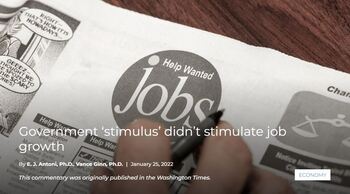 We were promised job growth—after all, that was the main selling point for the March 2021 American Rescue Plan Act (ARPA) from President Biden and the congressional Democrats. Promise made—promise broken. In February 2021, the Congressional Budget Office (CBO) issued its economic outlook and projected 6.252 million jobs would be added in 2021 without ARPA. The White House then projected ARPA would add 4 million additional jobs for a total of 10.252 million more jobs in 2021. ARPA was said to be necessary for the labor market recovery. Without it, job growth would slow, but with it, job growth would blossom. ARPA promised to get Americans back to work, get COVID-19 under control, and return the country to normal. None of this happened. According to the U.S. Department of Labor, the economy added just 6.116 million jobs in 2021, 136,000 fewer jobs than the CBO estimated without ARPA. At a cost of $1.9 trillion, ARPA was expensive from the start as it was added to an already bloated national debt. Now it appears the law added no jobs to the economy, and possibly cost jobs. It was not just expensive, it was also a detriment to the recovery. The marketing behind ARPA was nothing new; many spending bills have been sold to the American people as stimulus measures. But labeling government spending as “stimulus” is a misnomer. When the government spends money, it usually only stimulates more government, not productive activity in the private sector. This is partly because the government has no money of its own and it must get resources from the private sector before it can spend or redistribute them. That means any government spending has a cost which is often ignored by political pundits—but must be paid for all the same. Whether government spending is financed through taxes, borrowing, or inflation, it represents a burden on the private sector. Whatever alleged benefits are to be derived from government spending must be weighed against the cost of first acquiring the resources needed for that spending. The more government spends, the greater the burden on Americans. This was evident in the 2008-09 Great Recession and the slow recovery that followed. Despite record spending by the federal government (once again called stimulus), the economy recovered at the slowest pace since the Great Depression of the 1930s. While total output lagged, employment lagged even more when compared to other recessions. The labor market has now bogged down again. Despite 10.6 million job openings, the economy is still missing 3.6 million jobs as compared to before the pandemic and there are still 6.3 million people unemployed. Instead of supercharging the labor market recovery, trillions of borrowed dollars in new spending are hindering it. Because of direct cash payments, welfare expansions, unemployment “bonuses,” and other government transfer payments, many people are rationally choosing not to return to work. And while some of these programs have expired, their costly effects on people and the federal budget persist. On top of those pressures, exaggerated fears of the omicron variant along with mixed messaging from government health officials have made some people afraid to go back to work. Other people, particularly in the health care industry, have been hesitant to take a COVID-19 vaccine and have consequently been forced out of their jobs because of ill-advised mandates. The common factor in these examples is bad policy on the part of the government. Whether it is excessive regulation or spending, these public sector mistakes impact people’s lives in a very real—and negative—way. ARPA failed to deliver on its promise of growing jobs and instead grew government, especially government debt, which now stands at a mind-boggling nearly $30 trillion, far exceeding the entire U.S. economy. That debt is like an anchor weighing down future economic growth because it constantly requires interest payments, which sap the nation’s economic growth, meaning fewer jobs and less income. In FY 2021, taxpayers funded the second highest interest payment on the national debt—to the tune of a whopping $562 billion, with no end in sight. ARPA is just the latest in a long line of massive government spending programs that were billed as stimulus for the economy, but only stimulated more government. That is something to keep in mind the next time Washington promises us more jobs. https://www.texaspolicy.com/government-stimulus-didnt-stimulate-job-growth/ Comments are closed.
|
Vance Ginn, Ph.D.
|

 RSS Feed
RSS Feed